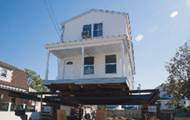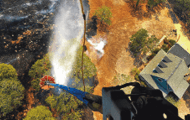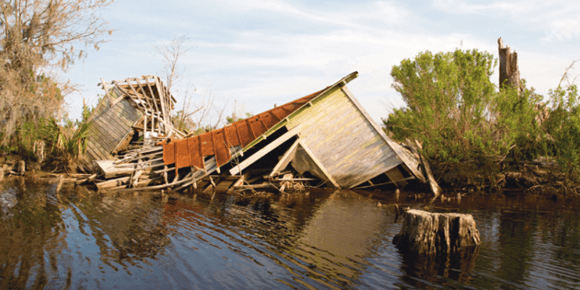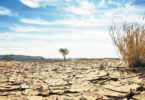When catastrophic natural disasters strike, REALTORS® play a critical role in helping communities recover.
By Donna Shryer
Between 1980 and 2014, the United States sustained 178 weather and climate disasters that cumulatively exceeded $1 trillion in damages. While a staggering dollar amount, the economic ramifications pale in comparison to the precious lives lost, the horrific memories endured by those who survived and the heart-wrenching obliteration of family treasures.
YOUR CRS NETWORK TO THE RESCUE

After Superstorm Sandy destroyed much of his community, Justin G. Leach, CRS, REALTOR® Associate with RE/MAX Real Estate Ltd in the coastal town of Brick, New Jersey, started phoning what he refers to as his fraternity.
As soon as I could, I called Certified Residential Specialists across the country and reached out for agent-to-agent education. I specifically called CRS members in Louisiana to ask what they did after Hurricane Katrina; how they dealt with FEMA; and how they approached new policies concerning elevation certificates.
Although Leach stresses that every natural disaster comes with unique characteristics, questions and needs, there are also overlapping solutions. By asking peers for advice, he was able to quickly increase his knowledge base and better serve his clients and community.
According to the Insurance Information Institute (I.I.I.), a natural catastrophe denotes events that cause $25 million or more in direct insured losses to property and affect a significant number of policyholders and insurers. Disaster losses along U.S. coastal areas in particular are predicted to escalate in the coming years, in part due to Mother Nature, but also because of significant increases in development. One catastrophe-modeling company predicts that catastrophe losses will double every decade or so due to growing residential and commercial density and the rising value of affected buildings.
If forced to find any good buried beneath natural catastrophic devastation whether due to earthquake, hurricane, flood, tornado or fire its the fact that such events bring to the forefront lionhearted champions dedicated to easing recovery. Every weather disaster gives us heroes and zeros, says Cynthia S. Joachim, CRS, real estate broker with Coldwell Banker Alfonso Realty, Inc. in Gulfport, Mississippi. Its a fact Joachim learned firsthand after struggling through Hurricane Katrina, which ravaged the Gulf Coast in August 2005 and is to date the costliest hurricane in U.S. history.
Joachim learned quickly that REALTORS® have the knowledge and resources to step up as heroes. I couldn’t save people from rooftops, but those of us in real estate have a responsibility to join first responders after a natural disaster. We bring so much to the table that no one else can.
Home Ground
Finding temporary rentals tops the list of support REALTORS® can immediately offer disaster victims. In the coastal town of Brick, New Jersey, Justin G. Leach, CRS, REALTOR® Associate with RE/MAX Real Estate Ltd., deals with rentals on a near-daily basis a fact that served his community well in autumn 2012 after Superstorm Sandy ripped apart much of the United States Northeastern coast. We represented homes outside the flood zone that were empty because they were either on the market or secondary vacation homes. I called every homeowner and asked if I might offer their home as a temporary residence for a displaced storm victim. The positive responses were remarkable, Leach explains. After Sandy hit, it felt like my family grew 300 percent.

A house is raised off its foundation in the Highlands, New Jersey, almost a year after Hurricane Sandy. Many houses in flood hazard areas were required to be elevated according to revised building codes issued in the aftermath of the disaster.
Leach also scoured daily MLS listings for vacant properties and then called the representing agent. These were not business transactions, he stresses. It was agents teaming up to help someone with no home.
As for Janis Penick, CRS, REALTOR® Associate with RE/MAX Bastrop Area, Bastrop, Texas, she had never dealt with rentals before the Bastrop County Complex fire struck her community in September 2011, recorded as the most destructive wildfire in Texas history. But even before the fire was contained, she learned what she needed to learn and fast. I did everything possible to help displaced neighbors and clients find rentals. The Bastrop County Board of REALTORS® created a daily list of available properties in her community, which was sent to the entire REALTOR® community, posted on the Boards website and also added to a unique Facebook page, Bastrop Fire Adopt a Family.
Reversing the Stigma
Historically speaking, areas destroyed by weather disasters go through an emotionally agitated period when buyers steer clear of the devastated area and homeowners want out. After Superstorm Sandy, no one wanted to touch waterfront property, Leach recalls. There was mass chaos and hysterical rumors, including a major network report citing Ocean County as one of the most dangerous areas in the world.

A CH-47 Chinook helicopter from the Texas Army National Guard uses a Bambi Bucket to dump water on a blaze during the Bastrop County Complex fire.
Fortunately, time quashes fiction-based predictions and the stigma of living within a previously demolished zone is soon replaced with a zest to rebuild. Were coming up on three years since Superstorm Sandy, and we have definitely turned the corner. A lot of positive things are happening today, says Edwin C. OMalley, broker/salesperson with Diane Turton, REALTOR® in the coastal town of Bay Head, New Jersey. OMalley, who is working to earn his CRS Designation, says that while buying and selling procedures, client concerns, disclosures and paperwork may have changed, the REALTOR® is in a prime position to help clients demystify these changes.
- Expert advice: REALTORS® have long been list keepers for reputable local contractors, builders and tradespeople, but post-disaster, these lists become an invaluable resource to expedite recovery. Buyers will want to know if a trusted company completed remediation and what quality materials the company is known to use. Sellers often ask for trusted experts to finish remediation so they can present their home in the best possible light.
- Certified checks and balances: A natural disaster typically increases the pile of paperwork needed to close a sale. For example, after both Superstorm Sandy and Hurricane Katrina, an updated Elevation Certificate (EC) became essential for homes near or on the water. These guidelines, created by the Federal Emergency Management Agencys (FEMA) Mitigation Assessment Teams, are intended to assist architects, builders, code officials, planners and engineers with reconstruction and new construction to create elevated flood-resistant homes. An EC is also instrumental in eventually determining new disaster insurance premium rates and/or support a request for a Letter of Map Amendment.
Homeowner’s Insurance Primer
While REALTORS® are not expected to be insurance experts, heres a quick primer to help define what a standard home insurance policy versus a disaster insurance policy should cover.
Leach quickly realized that he could provide a valuable client service by nailing down the legal jargon woven throughout the post-Sandy Elevation Certificate. In fact, Leachs group closed 126 transactions in 2012, representing approximately $31 million in sales. Leach attributes at least 20 of those sales to his expertise in post-Sandy home-elevation requirements.
- Nuts and Bolts: In the early years after Hurricane Katrina, Joachim describes a feverish period of buying and rehabbing. Work was happening so fast and people bought whatever materials they could find, Joachim says. Some of the work was done with Chinese drywall, which proved to be defective, emitting harmful gases that result in health problems for homeowners and deterioration of copper pipes, wiring and air conditioning coils. (Read more about problems with Chinese Drywall at the U.S. Consumer Product Safety Commissions website.)
Shes now a proactive advisor who has her clients schedule a home inspection to check for Chinese drywall. If defective drywall is identified, the solution is up to the buyer: They can walk away or replace the drywall, or they can seek legal advice to attempt to force the builder to replace the drywall. Whats important, Joachim stresses, is full disclosure concerning all rehab. Before Katrina, full rehab disclosure was mandated by state law, but Katrina added another layer of disclosure. Enforcing investigation of all rehab work including drywall, electrical wiring, roofing and insulation is something very important that the REALTOR® brings to the table.

A toilet water shut-off valve, showing corrosion from contamination by Chinese-made drywall. The defective product was used extensively during rebuilding efforts following Hurricane Katrina and several other gulf hurricanes between 2004 and 2007.
Wait and See Attitude
Sometimes, Leach stresses, the best service a REALTOR® can offer any client whos suffered through an abysmal natural catastrophe is the assurance that predictions of crippling supplemental disaster insurance hikes and new, cost-prohibitive building codes are merely speculation. Right after Superstorm Sandy, reports came out that flood insurance would skyrocket exceeding a homeowners mortgage in some cases. That sent everyone into a panic, Leach says. The truth is, three years after Sandy, we still dont know whats going to happen with flood insurance rates once FEMAs new maps are adopted. And we wont likely know for some time. It took seven years to develop new maps for the Gulf Coast after Hurricane Katrina. Thats a long time to give up your dream home. Sometimes my best advice is to live for today.








